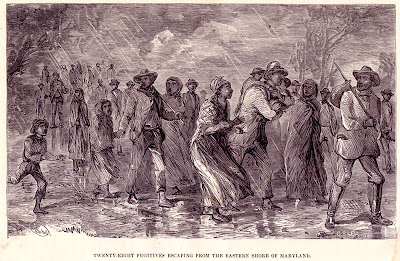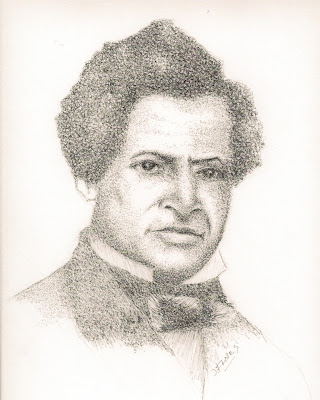 The annual Capital District Underground Railroad Conference will be held this weekend in Troy, NY on April 8, 9 and 10th at the Russell Sage Campus in celebration of the conference’s tenth year presenting workshops, music, and stories about the historic struggle to escape slavery.
The annual Capital District Underground Railroad Conference will be held this weekend in Troy, NY on April 8, 9 and 10th at the Russell Sage Campus in celebration of the conference’s tenth year presenting workshops, music, and stories about the historic struggle to escape slavery.
In the words of the conference founders, Mary Liz and Paul Stewart, the conference activities are, “a fresh interpretation of an Old Story. “ This is the story of the heroic men, women and children who escaped from slavery and who traveled to new, free, lives along the Underground Railroad.
The international conference is titled, “Abolishing Slavery in the Atlantic World: the ‘Underground Railroad’ in the Americas, Africa and Europe, and its relationship with us today.” Several hundred attendees are expected at workshops, art exhibits, and musical events. The conference is organized by the Underground Railroad History Project of the Capital Region, Inc., (URHPCR) co-sponsored by Russell Sage College and the College’s Department of History and Society. Several non-profit groups are collaborating: Rensselaer County Historical Society, Museumwise, and the New York State Office of Parks, Recreation and Historic Preservation.
On Friday April 8th, 2011 the Opening Address will be given by Dr. Robin Blackburn at 7:00 pm, Bush Memorial, Russell Sage College, Troy, NY, “The International Struggle to End Slavery and the Slave Trade and Its Ramifications Today.” Dr. Blackburn, Professor of Sociology at the University of Essex in England and Visiting Professor of Historical Studies at the New School for Social Research in New York, will describe the international slave trade which fueled the American Colonial economy and he will explore the ramifications for today of the struggle to end slavery. Performing are Kim and Reggie Harris.
Blackburn has taught in England at King’s College, Cambridge University, FLACSO (Latin American Social Science Faculty)- in Ecuador, and at the Woodrow Wilson Center in Washington, D.C. He has studied and taught at the London School of Economics and Oxford University. He is the author of many books and scholarly articles on historical sociology and critical social theory. Two of his most important books are The Making of New World Slavery: from the Baroque to the Modern, 1492-1800, and The Overthrow of Colonial Slavery, 1776-1848. In recent years he has written several influential articles on slavery and resistance. He is the founding editor of The New Left Review and an editor at Verso Books. Blackburn’s Opening Address at the conference will bring a high level of scholarship and an international perspective to discussions about the historical struggle for freedom from slavery in the United States.
The Underground Railroad Conference in Troy is a venue for African American art exhibits, storytelling, history workshops, and programs for educators and people of all ages. A Workshop for Educators on Friday April 8th is followed on Saturday April 9th with speakers, workshops, a raffle, art exhibit, reception and evening award ceremony. Keynote speakers on Saturday are Dr. Franklin Knight, Stulman Professor of History at Johns Hopkins University, Baltimore, speaking about slave societies. His talk opens the conference at 9:00 am and is titled, “Of Slavery and Abolitions: Perspectives from the World of Slaves.” After the morning workshops at 1:00 pm Tony Burroughs, internationally known lecturer on genealogy, a guest speaker on many television talk shows, will participate in a panel discussion called, “Heritage Preservation Through Genealogical Research, Song and Storytelling.” Joining him on the panel are singer, MaryNell Morgan and storyteller, Miki Conn. Saturday afternoon workshops conclude at 5:00 pm followed by an evening reception and art exhibit held at the Rensselaer County Historical Society located at 57 Second Street, Troy, NY.
The conference continues on Sunday April 10th at 2:00 pm in Russell Sage College’s Bush Memorial Hall with programs devoted to music and performance. There will be performances by the Hamilton Hill Dancers, Garland Nelson, MaryNell Morgan, Eshu Bumpus, Magpie, Sparky and Rhonda Rucker, Graham and Barbara Dean, the musical group Peter, Paul and George, the Hamilton Hill Dancers, and the Hamilton Hill Drummers.
The conference is possible thanks to leadership from co-founders Mary Liz and Paul Stewart, the contribution of volunteers with the URHPCR, Inc., and conference donors and supporters: M & T Bank, Erie Canalway National Heritage Corridor, Russell Sage College, Kate Storms, The Community Foundation for the Greater Capital Region’s Standish Family Fund, The Alice Moore Foundation, Museumwise, the Arts Center of the Capital Region, New York Council for the Humanities, Pioneer Bank and Troy Savings Bank Charitable Foundation.
Find conference information and register online at www.ugrworkshop.com. Contact Paul Stewart at (518) 432-4432.
The 11th Anniversary Conference on the Underground Railroad Movement, sponsored by the Underground Railroad History Project of the Capital Region Conference, will be held at Russell Sage College in Troy, April 13-15th. This year’s conference, “The Underground Railroad Turned On Its Head – Old Themes, New Directions,” focuses on new research on the Underground Railroad, slavery, abolition and the 19th century. Old assumptions such as “There is little documentation of the Underground Railroad”, “The UGRR was a string of safe houses to Canada” and numerous other ideas are challenged by new research and interpretations.







